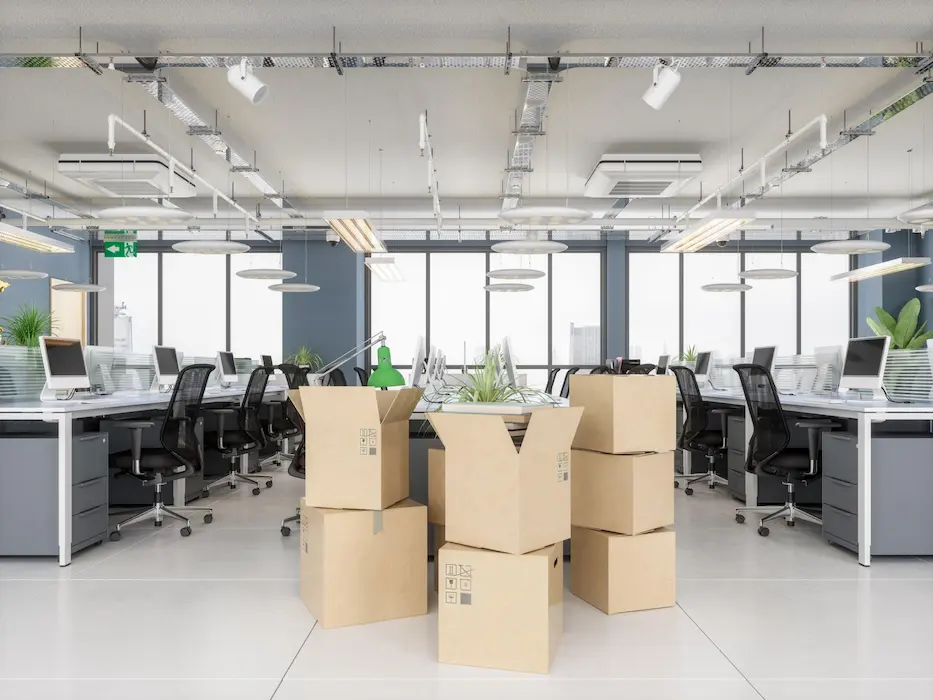Office relocation is significant for any business, signaling growth, change, or strategic realignment. Moving to a new office space offers opportunities for innovation and improved functionality. Still, it also comes with its share of challenges, particularly in cost. The average cost of relocating an office is between £3,500 and £15,000 in the UK.
In this article, we’ll delve into the various factors that influence the cost of office relocation, from planning and budgeting to logistical considerations and employee needs.
Setting the Scene for Office Relocation
Moving an office involves more than just packing up desks and files. It’s a complex process that requires careful planning to ensure a smooth transition. The significance of this move can’t be understated; it’s not just about changing physical locations but also about fostering a positive environment that enhances productivity and reflects the company’s values.
The Significance of Planning and Budgeting
Effective planning and budgeting are the cornerstones of a successful office relocation. Without a clear roadmap, costs can spiral out of control, leading to unexpected financial strain. A well-thought-out plan allows the business to anticipate expenses, allocate resources appropriately, and ensure a seamless transition.
How Much Does It Cost to Relocate an Office
We will discuss some important points to know how much it costs to relocate an office. Discussing preparation, planning, and cost of relocating an office is essential.
Factors Influencing Office Relocation Costs
Several factors play a crucial role in determining the cost of relocating an office:
Location of the New Office
The location of the new office is a significant factor in cost considerations. Real estate prices, accessibility, and proximity to clients or partners can impact the overall expense.
Size and Layout of the New Space
The size and layout of the new office space influence the cost of furniture, equipment, and potential renovations. A larger area requires more furnishings and customization.

Distance Between Old and New Offices
The distance between the old and new offices affects transportation costs and logistical complexities. Longer lengths may necessitate additional planning and expenses.
Industry-Specific Requirements
Specific industries have unique needs that can impact relocation costs. For example, technology companies might require advanced IT infrastructure, while laboratories need specialized equipment transportation.
How Much Does It Cost to Pack and Move
The cost of packing and moving includes expenses related to packing materials, labor for packing, loading, transportation, unloading, and unpacking. Fragile or sensitive items might require specialized handling.
Preparation and Planning
Importance of a Detailed Relocation Plan
Creating a comprehensive relocation plan is essential for a successful move. This plan should outline the entire process, including tasks, responsibilities, timelines, and milestones.

Identifying Key Stakeholders and Roles
Clearly defining who is responsible for what helps prevent confusion and ensures a coordinated effort. Key stakeholders include department heads, IT specialists, and project managers.
Creating a Timeline for the Relocation Process
A realistic timeline outlines when each phase of the relocation will occur. This timeline should account for potential delays and include contingencies.
Budgeting for Office Relocation
Determining the Overall Budget
Estimating the overall budget involves considering all aspects of the move, from real estate costs to new furniture and IT infrastructure.
Allocating Funds for Different Expenses
Dividing the budget into categories such as real estate, moving, technology setup, and renovations helps allocate funds more effectively.
Contingency Planning for Unexpected Costs
Unforeseen expenses are every day during relocations. Setting aside a contingency fund ensures the move can proceed smoothly, even with unexpected challenges.

Cost Breakdown: Key Expenses
Office Space Leasing or Purchase
Leasing or purchasing the new office space is a significant expense. Lease terms, location, and size all contribute to this cost.
Moving and Transportation Costs
Transportation costs include expenses for moving company services, vehicles, and insurance coverage for belongings.
Technology and IT Infrastructure Setup
Setting up IT infrastructure, including internet connectivity, servers, and software, is critical to modern office relocation.
Furniture and Equipment Procurement
Furniture and equipment costs can vary significantly based on quality and quantity. Careful selection is crucial to meet the functional and aesthetic needs of the new space.
Renovations and Office Customization
Suppose the new space requires renovations or customization to align with the company’s brand and culture. In that case, these costs must be factored in.
Professional Services
Hiring Professional Relocation Services
Engaging professional relocation services can streamline the moving process and ensure that items arrive safely and on time.
Hire Man And Van in the UK
Man and van services provide a versatile and convenient solution for various moving and transportation needs. With a reliable man and van team, individuals and businesses can seamlessly relocate their belongings, whether it’s a single item or a full load, without the hassle of hiring larger moving companies. These services typically offer a skilled professional, often accompanied by a well-equipped van, capable of handling loading, transportation, and unloading. Man and Van provide house removal, furniture removal, office removal, and other moving services.

Real Estate Agents and Legal Advisors
Real estate agents and legal advisors assist with property search, negotiation, and lease or purchase agreements.
IT Consultants for Tech Migration
IT consultants are pivotal in migrating technology systems, ensuring minimal downtime and data loss.
Interior Designers and Architects
Interior designers and architects contribute to creating a functional and visually appealing workspace.
Employee Considerations
Employee Relocation Packages
Relocating employees might require assistance with moving expenses, temporary housing, and adjusting to the new location.
Communication and Addressing Concerns
Open communication is critical to alleviating employee concerns and maintaining morale during the transition.
Temporary Housing Arrangements
Providing temporary housing arrangements can ease relocation stress for employees who need to move.
Logistics and Timeline
Logistics of Packing and Unpacking
Efficiently packing and unpacking items requires careful planning and coordination.
Developing a Detailed Moving Schedule
A detailed schedule ensures that each move phase occurs at the right time, minimizing disruption.
Minimizing Disruption to Business Operations
Strategies to minimize disruption include staggered move schedules and temporary relocations for critical operations.
Technology and Communication Setup
Installing and Configuring IT Infrastructure
IT experts set up servers, workstations, and communication systems to ensure seamless operations.

Ensuring Seamless Communication During the Transition
Maintaining communication during the move is vital for business continuity.
Testing and Troubleshooting Technology Systems
Thorough testing helps identify and address technical glitches before they impact operations.
Furniture and Interior Setup
Choosing Office Furniture and Layout
Careful selection of furniture and layout contributes to employee comfort and productivity.
Collaborating With Interior Designers
Interior designers collaborate to create a workspace that aligns with the company’s brand and culture.
Creating an Ergonomic and Functional Workspace
Prioritizing ergonomics in furniture selection and layout improves employee well-being and productivity.
Legal and Compliance Factors
Addressing Legal Requirements and Permits
Complying with legal requirements and obtaining necessary permits are critical to avoid legal issues.
Compliance With Building Codes and Regulations
Meeting building codes ensures the safety and accessibility of the new office space.
Potential Impact on Licenses and Certifications
Relocation can affect licenses and certifications, so updating them as needed is essential.
Renovation and Customization
Renovation Costs and Considerations
Renovation costs depend on the extent of changes needed in the new space.

Customizing the Office Space to Fit the Company’s Brand
Customization reflects the company’s identity and can positively impact employee morale.
Balancing Aesthetics With Practicality
Aesthetic choices should also consider practicality and functionality.
Risk Management
Identifying Potential Risks and Challenges
Anticipating risks allows for proactive mitigation strategies.
Developing Mitigation Strategies
Mitigation strategies minimize the impact of potential challenges.
Contingency Plans for Unforeseen Circumstances
Having contingency plans in place prepares the business for unexpected events.
Communication Plan
Keeping Stakeholders Informed Throughout the Process
Regular updates keep stakeholders informed and engaged.
Internal and External Communication Strategies
Different communication strategies are required for internal and external stakeholders.
Managing Expectations and Addressing Concerns
Addressing concerns proactively helps manage expectations and reduce anxiety.
Minimizing Disruption
Strategies for Maintaining Productivity
Implementing strategies to maintain productivity during the move is crucial.
Temporary Relocation of Critical Operations
Some operations might need temporary relocation to ensure seamless operations.
Employee Training for New Systems and Processes
Proper training helps employees adapt to new systems and processes.

Post-Relocation Evaluation
Assessing the Success of the Relocation
Evaluation measures the success of the relocation against predetermined goals.
Gathering Feedback from Employees
Employee feedback provides insights for further improvements.
Making Necessary Adjustments for Optimal Workflow
Adjustments based on feedback ensure an optimized workflow.
Refurbishment Costs
Refurbishment costs should be considered for any renovations or upgrades.
Schedule of Conditions Cost
Assessing the conditions of the new office space might incur additional expenses.
Conclusion
Relocating an office is a complex endeavor with many costs to consider. Thorough planning, budgeting, and careful execution are essential for a successful transition. By addressing the factors discussed in this article, businesses can navigate the challenges of office relocation while minimizing disruptions and optimizing their new workspace.
FAQs
What is the relocation cost?
Relocation cost refers to the expenses incurred when moving from one location to another, including factors like packing, transportation, setup, and any additional services required.
How much does it cost to move an office in the UK?
The cost of moving an office in the UK varies based on location, office size, services needed, and specific requirements. Proper planning helps estimate and manage these costs effectively.
What to do for an office relocation?
For office relocation, create a detailed plan including tasks, responsibilities, and timelines. Identify key stakeholders, allocate a budget, arrange professional services, address employee needs, and ensure seamless communication.
How much does it cost to move an office in London?
The cost of moving an office in London depends on various factors, such as the size of the office, the distance to the new location, services required, and more. Obtain quotes and estimates from moving and service providers to determine a suitable budget.



